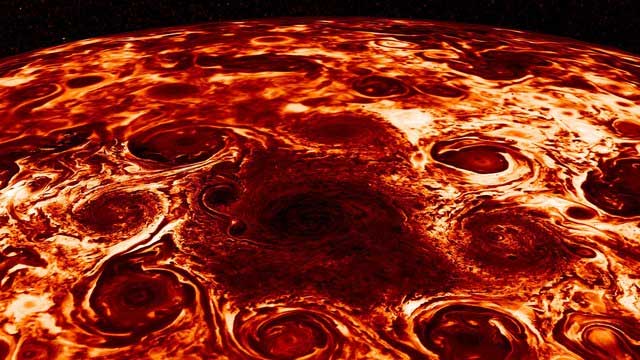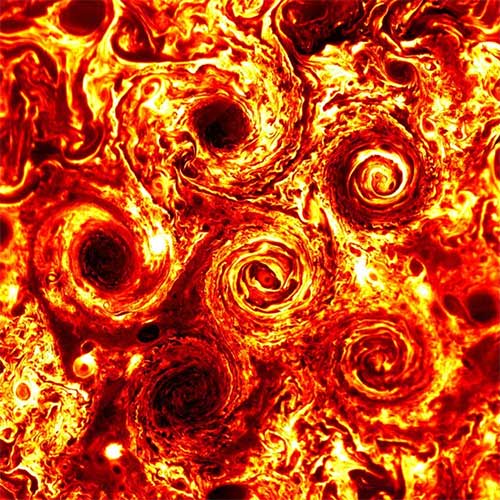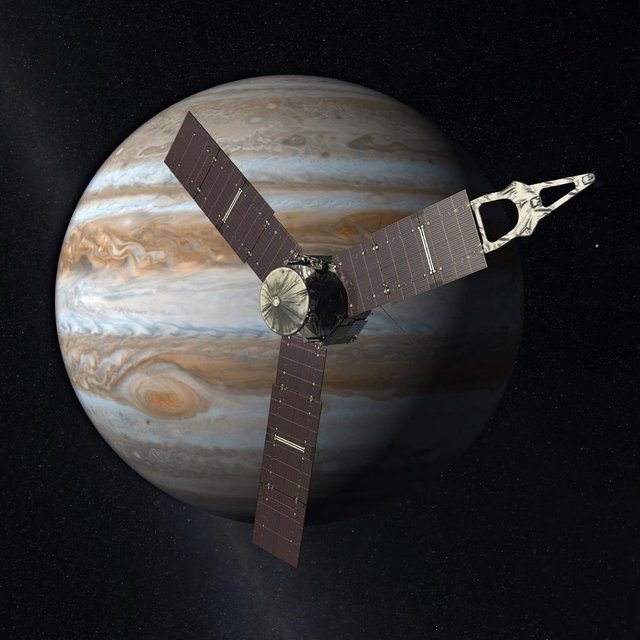Scientists suggest that this could be a sign of physical phenomena on Jupiter that humans have yet to understand.
In Jupiter’s atmosphere, massive cyclones have been forming stable, organized shapes that persist for many years before dissipating. To date, the scientific community has yet to explain this fascinating phenomenon, with many researchers optimistically believing we are witnessing entirely new concepts and physical formulas.
Our knowledge of these cyclones comes from NASA’s Juno mission, which began in 2016. In Jupiter’s northern hemisphere, a cyclone is located near the center of the pole, surrounded by eight other cyclones, creating a peculiar octagonal shape. In the southern hemisphere, another cluster of cyclones forms a pentagonal shape.

The octagonal shape in Jupiter’s northern hemisphere formed by cyclones. (Image: NASA).

The pentagonal shape in Jupiter’s southern hemisphere.
To explain the “extraterrestrial” phenomenon, a team of scientists led by Professor Andrew Ingersoll began analyzing data sent back by the Juno spacecraft. The research results indicate that these cyclones, comparable in size to the United States, are generated by a jet stream that counteracts the cyclone’s rotation, creating a “stability of the polygonal cyclone pattern“. However, the research report published in the journal Nature continues to pose challenging questions.
“Since 2017, the Juno spacecraft has observed a cyclone at the North Pole of Jupiter surrounded by eight other cyclones, forming an octagonal shape. It is unclear why this structure is so stable, and even less clear how it can persist for such a long time,” the researchers wrote in the report.

Professor Andrew Ingersoll. (Image: Caltech).
“The polygonal structure and the individual cyclones that form this structure have been rotating stably for four years since Juno discovered them,” the team of scientists stated. “The polygonal structure rotates very slowly, or almost not at all… In contrast, Jupiter possesses [two cyclones] at each pole.”
To understand how the polygonal structure forms and stabilizes, Professor Ingersoll and his colleagues measured Jupiter’s winds and storm-forming factors using the equipment aboard Juno. They discovered special wind currents that seem to create a “scaffold” to fix the positions of the cyclones. However, the research team did not find convective factors in Jupiter’s winds, which contradicts previous studies on Jupiter’s cyclones.
The team concluded that further research will be needed to explain the discrepancies in scientific reports. Ingersoll also confirmed that the team’s research “focuses on the rotation and stability [of Jupiter’s cyclones], indicating that this is a valid research direction.”

NASA’s Juno spacecraft. (Image: NASA).
These beautifully shaped storms are just one of many fascinating phenomena occurring on Jupiter. As the largest planet in the Solar System, it serves as an ideal research model; from Jupiter, we can infer strange phenomena occurring on other planets as well.
In a statement issued by NASA in 2019, researcher Li Cheng from the Juno project and co-author of the new study remarked: “These cyclones are bizarre weather phenomena that have never been observed or predicted. Nature is presenting new physical concepts related to the motion of [matter] and how climate operates on large planets. We are just beginning to understand them through observation and simulation software. Future Juno missions will help us refine our understanding to discover how cyclones form over time.”


















































